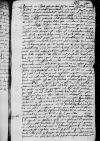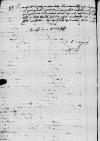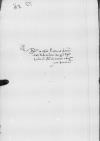List #2012
Ioannes DANTISCUS do Tiedemann GIESEHeilsberg (Lidzbark Warmiński), 1538-12-09
Regest polski:
Dantyszek ustosunkowuje się do rady wojewody malborskiego [Jerzego Bażyńskiego] w sprawie podatku. Zgodziłby się na zatrzymanie podatku do następnego sejmu [Prus Królewskich], gdyby wszyscy [radcy pruscy] byli jednomyślni, ponieważ jednak nie są, zamierza zastosować się ściśle do mandatu królewskiego i jak najszybciej wysłać pieniądze z podatku do Malborka.
Wobec braku dbałości większości [radców pruskich] o sprawy publiczne Dantyszek wyraża niepokój o losy przywilejów i immunitetów [pruskich] po śmierci sędziwego już wojewody [malborskiego]. Przewiduje, że bez jego wsparcia nie będzie w stanie ich bronić.
Dantyszek jest wdzięczny Giesemu i wojewodzie malborskiemu za współczucie, nie uważa jednak za konieczne interweniować na dworze królewskim, póki nie otrzyma odpowiedzi na swój list [IDL 2001]. Sugeruje, aby rozesłać wojewodom kopie listu [Rady Pruskiej] do króla w sprawie kontrybucji z ostatniego sejmu grudziądzkiego. Jeżeli Giese zechciałby to uczynić, ułatwiłby odwoływanie się do owego listu w razie konieczności obrony Dantyszka.
Dantyszek dowiedział się, że plebani: lubawski i kazanicki (?) (Casnicensis) domagają się od zarządców kościoła [w Chełmnie] zwrotu pieniędzy przekazanych niegdyś przez bractwo kapłanów na odbudowę kościoła po pożarze, który dotknął miasto za pontyfikatu Dantyszka. Dantyszek uważa ich żądania za niesłuszne.
Rękopiśmienne podstawy źródłowe:
Publikacje:
| ||||||||
Tekst + aparat krytyczny + komentarz Zwykły tekst Tekst + komentarz Tekst + aparat krytyczny
Reverendissimo in Christo Patri et Domino, domino
Reverendissime in Christo Pater et Domine, frater et amice carissime et honora[n](de) or honora[n](dissimee)⌈honoran paper damaged⌈[n]n paper damaged⌉(de)honora[n](de) or honora[n](dissimee)⌉ .
Salutem et studiosam commendationem.
Consilium magnifici domini
Proinde omnem contributam pecuniam, cuius ne assem quidem sum visurus, cum primis
Ceterum, quod Dominatio Vestra Reverendissima cum domino
Cum superioribus annis in sede essem Dominationis Vestrae Reverendissimae,[3] post conflagratum  BCz, 245, p. 110 infectacf. Pl. Am. 885 ea quae sunt facta infecta ut reddat clamitat ⌋. Quae in societate illa sacerdotum erant deposita, in pios quidem usus et non privatos cedebant. Nisi fuisset ea pecunia et nescio quid ex me adminiculi, adhuc omnia in loco ecclesiae plena essent ruderibus.
BCz, 245, p. 110 infectacf. Pl. Am. 885 ea quae sunt facta infecta ut reddat clamitat ⌋. Quae in societate illa sacerdotum erant deposita, in pios quidem usus et non privatos cedebant. Nisi fuisset ea pecunia et nescio quid ex me adminiculi, adhuc omnia in loco ecclesiae plena essent ruderibus.
Dominatio Vestra Reverendissima feliciter valeat.
Ex
Eiusdem Dominationi Vestrae Reverendissimae deditissimus


